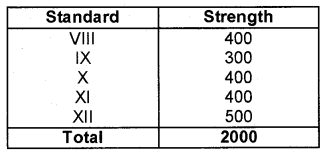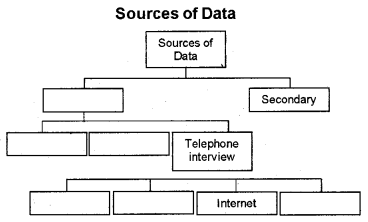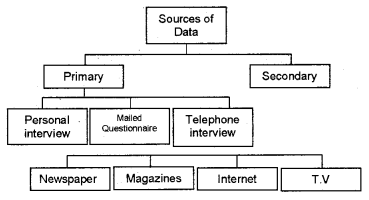Kerala Plus One Economics Chapter Wise Previous Questions Chapter 12 Collection of Data
Question 1.
Suppose you want to study the academic standard of the students at your school. The class-wise strength is given below. (March 2009)

If you want to select a sample of 100 students, which method you would prefer?
Answer:
Stratified sampling
Question 2.
Fill in the missing links in the following flow chart. (March 2009)

Answer:

Question 3.
Suppose you have to analyse the trend of consumption habits of the people of Kerala. Will you suggest an appropriate method of sampling for this study. (Say 2009)
Answer:
Stratified sampling
Question 4.
Krishna is a research student at Cochin University. He is doing research on poverty among slum dwellers. He conducted a pre-test before the actual survey begins. Mention the advantages of conducting such a survey. (March 2010)
Answer:
Once the questionnaire is ready, it is advisable to conduct a try-out with a small group which is known as Pilot Survey or Pre-Testing of the questionnaire. The pilot survey helps the investigator in the following ways.
- The pilot survey helps in providing a preliminary idea about the survey.
- It helps in pre-testing the questionnaire, so as to know the shortcomings and drawbacks of the questions.
- A pilot survey also helps in assessing the suitability of questions, clarity of instructions, the performance of enumerators, and the cost and time involved in the actual survey.
Question 5.
Santhi wants to conduct a study on the energy consumption pattern of rural households. State the various methods of data collection she can conduct to obtain data from rural households. (March 2010)
Answer:
- Personal interview
- Mailed questionnaire method
- Telephone interview
Question 6.
Suppose you are asked to suggest an appropriate method of the survey for studying the socio-economic conditions of the traditional labour force in Kerala. Suggest a method and give reasons. (March 2011)
Answer:
Census and Sample Surveys
A survey, which includes every element of the population, is known as Census or the Method of Complete Enumeration. The essential feature of this method is that this covers every individual unit in the entire population.
Sample Survey
Population or the Universe in statistics means the totality of the items under study. Thus, the Population the Universe is a group to which the results of the study are intended to apply. There are two methods of sampling namely, random sampling and non-random sampling. They are explained below.
Random Sampling
As the name suggests, random sampling is one where the individual units from the population (samples) are selected at random. In random sampling, every individual has an equal chance of being selected and the individuals who are selected are just like the ones who are not selected. This method is also known as the lottery method. The sampling can be selected using a Random Number Table also.
Question 7.
Your Panchayath wishes to provide better health care facilities to its people. You are requested to collect information about the present facilities available in the Panchayath and the health care requirements of the people in the Panchayath. Prepare at least 12 questions about the state of public health infrastructure in the Panchayath, different systems of medicine people follow, and the special needs of women and children. (March 2012)
Answer:
Prepare a list of any 12 questions related to the state of health infrastructure
Question 8.
Sandeep is a research student, after preparing the questionnaire, he wants to conduct a pilot survey. Explain the advantages of a pilot survey. (Say 2012)
Answer:
Once the questionnaire is ready, it is advisable to conduct a try-out with a small group which is known as Pilot Survey or Pre-Testing of the questionnaire. The pilot survey helps the investigator in the following ways.
- The pilot survey helps in providing a preliminary idea about the survey.
- It helps in pre-testing of the questionnaire, so as to know the shortcomings and drawbacks of the questions.
- A pilot survey also helps in assessing the suitability of questions, clarity of instructions, the performance of enumerators, and the cost and time involved in the actual survey.
Question 9.
Distinguish between a discrete and a continuous variable. (Say 2012)
Answer:
A simple definition of the variable does not tell you how it varies. Different variables vary differently and depending on the way they vary, they are broadly classified into two types:
- Continuous
- Discrete.
A continuous variable can take any numerical value. It may take integral values (1, 2, 3, 4,…) or fractional values(1/2, 2/3, 3/4). For example, the height of a student, as he/she grows say from 90 cm to 150 cm, would take all the values in between them.
Unlike a continuous variable, a discrete variable can take only certain values. Its value changes only by finite “jumps”. It “jumps” from one value to another but does not take any intermediate value between them. For example, a variable like the “number of students in a class”, for different classes, would assume values that are only whole numbers.
Question 10.
Connect A with B. (Say 2012)
| A | B |
| a) Survey | a) Computer enumeration |
| b) Statistics | b) Arranging similar things into groups |
| c) Census | c) To collect data |
| d) Classification | d) Discrete variable |
| e) Frequency array | e) Numerical facts systematically collected |
Answer:
a) – c
b) – d
c) – a
d) – e
e) – b
Question 11.
Distinguish between the census survey and sample survey. (Say 2013)
Answer:
Census
A survey, which includes every element of the population, is known as Census or the Method of Complete Enumeration. The essential feature of this method is that this covers every individual unit in the entire population.
Sample Survey
Population or the Universe in statistics means the totality of the items under study. Thus, the Population or the Universe is a group to which the results of the study are intended to apply. There are two methods of sampling namely, random sampling and non-random sampling.
Question 12.
You are asked to conduct a survey to study farming practices and the problems facing farmers in a village. Frame five two-way questions to include in the questionnaire (with Yes or No). (March 2014)
Answer:
- Are you depending only on rainfall for cultivation: Yes/No
- Is there a significant change in your cropping pattern: Yes/No
- Do you get any price support from the government: Yes/No
- Has globalization policies affected your farming: Yes/No
- Do you adopt mechanization in farming: Yes/No
Question 13.
Some particulars from a class timetable are given below. By using them, fill the columns in the table correctly. (Say 2014)

Answer:
- Title: Class time table
- Caption: Periods
- Stub: Days
- Body: English, Economics
- Note: Nil
Question 14.
A researcher wants to collect data from some remote areas, where there are no telephone facilities and conveyance. (Say 2014)
a) Suggest her a suitable mode of data collection.
b) State any two merits of that method.
Answer:
a) Mailed questionnaire method
b) Advantages of the mailed questionnaire method are the following.
- Least expensive
- The only method to reach remote areas
- No influence on respondents
- Better for sensitive questions
Question 15.
“Individuals who are selected are just like the ones who are not selected”. Identify the statistical technique mentioned here. (Say 2014)
Answer:
Sampling
Question 16.
Hafis collected the following three pictures as a part of a project on a topic in +1 Economics. (Say 2014)

- Can you identify the topic on which he is preparing the project?
- Suggest any four other areas from which data/pictures are to be collected for the same project.
Answer:
- Non-conventional energy source.
- wind, water, geothermal, and biomass.
Question 17.
Distinguish between primary data and secondary data with examples. (March 2015)
Answer:
Primary data: Data collected by the investigator himself/ herself for a specific purpose.
Examples: Data collected for the first time by a student for his/her thesis or research project.
Secondary data: Data collected by someone else for some other purpose (but being utilized by the investigator for another purpose).
Examples: Census data is used to analyze the impact of education on career choice and earning.
Question 18.
Distinguish between sampling and non-sampling error in data collection. (Say 2015)
Answer:
The purpose of the sample is to take an estimate of the population. Sampling error refers to the differences between the sample estimate and the actual value of a characteristic of the population. It is the error that occurs when you make an observation from the sample taken from the population. Thus, the difference between the actual value of a parameter of the population and its estimate is the sampling error.
Non-sampling errors are more serious than sampling errors because a sampling error can be minimized by taking a larger sample. It is difficult to minimize non-sampling error, even by taking a large sample. Some of the non-sampling errors are:
- Errors in Data Acquisition: This type of error arises from a recording of incorrect responses.
- Non-Response Errors: Non-response occurs if an interviewer is unable to contact a person listed in the sample or a person from the sample refuses to respond.
- Sampling Bias: Sampling bias occurs when the sampling plan is such that some members of the target population could not possibly be included in the sample.
Question 19.
a) Differentiate between the primary data and secondary data. (Say 2015)
b) List the sources of primary and secondary data.
Answer:
Mode of Data Collection
There are three basic ways of collecting data:
- Personal Interviews,
- Mailing (questionnaire) Surveys,
- Telephone Interviews
a) Personal Interviews: This method is used when the researcher has access to all the members. The researcher conducts face to face interviews with the respondents. Personal contact is made between the respondent and the interviewer. The interviewer has the opportunity of explaining the study and answering any query of the respondents.
b) Mailing Questionnaire: When the data in a survey are collected by mail, the questionnaire is sent to each individual by mail with a request to complete and return it by a given date. The advantages of this method are that it is less expensive. It allows the researchers to have access to people in remote areas too, who might be difficult to reach in person or by telephone. It does not allow the influence of the respondents by the interviewer. It also permits the respondents to take sufficient time to give thoughtful answers to the questions.
c) Telephone Interviews: In a telephone interview, the investigator asks questions overthe telephone. The advantages of telephone interviews are that they are cheaper than personal interviews and can be conducted in a shorter time. They allow the researcher to assist the respondent by clarifying the questions. The telephone interview is better in the cases where the respondents are reluctant to answer certain questions in personal interviews.
Question 20.
Write any two examples each for quantitative and qualitative data. (March 2016)
Answer:
Quantitative data
- Height
- Weight
Qualitative data
- Gender
- Nationality
Question 21.
Prepare a table that shows the differences between the census survey and sample survey. (March 2016)
Answer:
A survey, which includes every element of the population, is known as Census or the Method of Complete Enumeration. The essential feature of this method is that this covers every individual unit in the entire population.
Sample Survey
Population or the Universe in statistics means the totality of the items under study. Thus, the Population or the Universe is a group to which the results of the study are intended to apply. There are two methods of sampling namely, random sampling and non-random sampling. They are explained below.
a) Random Sampling: As the name suggests, random sampling is one where the individual units from the population (samples) are selected at random.
b) Non-Random Sampling: In a non-random sampling method all the units of the population do not have an equal chance of being selected and convenience or judgment of the investigator plays an important role in the selection of the sample.
Question 22.
The main sources of data are ________ (March 2016)
a) Primary
b) Secondary
c) Both ‘a’ and ‘b’
d) None of these
Answer:
c) Both ‘a’ and ‘b’
Question 23.
Enumerate the different methods of sampling. (Say 2016)
Answer:
Different methods of sampling
There are two types of sampling
- Random sampling
- Nonrandom sampling
I) Random sampling
In random sampling, every individual unit in the population gets an equal chance of being selected. There are two methods for selecting random samples. They are the following.
- Lottery method: The selection of items under this method depends on chance. The personal prejudices of the enumerator will not influence the selection of the item.
- Random number table: The random numbers have been published in the form of tables. The property of it is that we can use the tables from anywhere, from any page, column or row point, 2 digits, 3 digits, etc., can be used for this purpose.
II) Non-random sampling
In this method, all the units of the population do not have an equal chance of being selected. Such selected items may not have the characteristics of the population.
Question 24.
“Most of the surveys conducted in India are sample surveys”. Prepare any three reasons to support the above statement. (March 2017)
Answer:
- Lower cost
- Shorter time
- Sample can provide reasonable information
Question 25.
For conducting a survey among 200 households, Anumitha has written the names of all 200 households on pieces of paper, mixed them well and 20 names are selected one by one. It is __________ (March 2017)
a) Census method
b) Random sampling
c) Nonrandom sampling
d) None of these
Answer:
b) Random sampling
